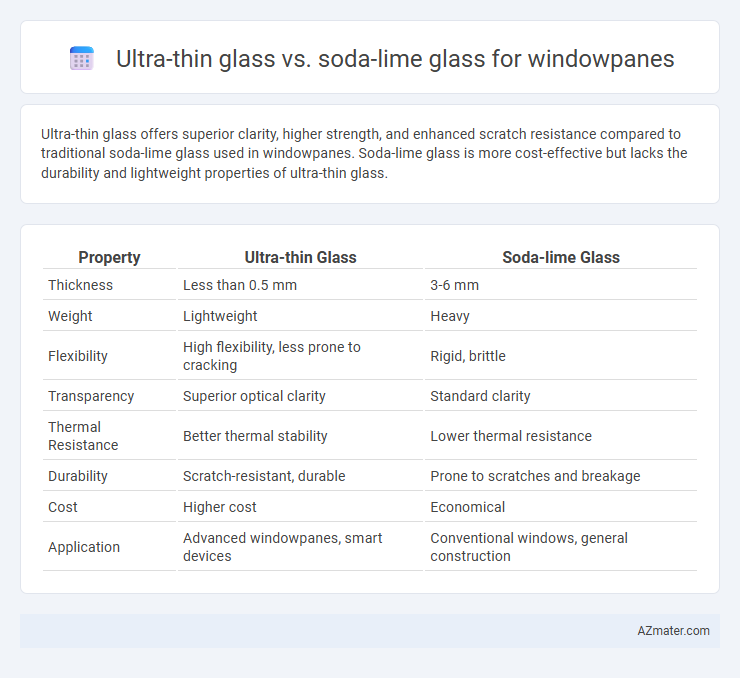Ultra-thin glass offers superior clarity, higher strength, and enhanced scratch resistance compared to traditional soda-lime glass used in windowpanes. Soda-lime glass is more cost-effective but lacks the durability and lightweight properties of ultra-thin glass.
Table of Comparison
| Property | Ultra-thin Glass | Soda-lime Glass |
|---|---|---|
| Thickness | Less than 0.5 mm | 3-6 mm |
| Weight | Lightweight | Heavy |
| Flexibility | High flexibility, less prone to cracking | Rigid, brittle |
| Transparency | Superior optical clarity | Standard clarity |
| Thermal Resistance | Better thermal stability | Lower thermal resistance |
| Durability | Scratch-resistant, durable | Prone to scratches and breakage |
| Cost | Higher cost | Economical |
| Application | Advanced windowpanes, smart devices | Conventional windows, general construction |
Introduction to Ultra-thin and Soda-lime Glass
Ultra-thin glass offers exceptional flexibility and lightweight properties compared to traditional soda-lime glass, making it ideal for modern windowpane applications requiring slim profiles and high durability. Soda-lime glass, the most common type of glass used in windowpanes, provides cost-effective strength and excellent clarity but lacks the thinness and flexibility of ultra-thin glass. The choice between ultra-thin and soda-lime glass depends on performance needs, cost considerations, and design requirements for energy efficiency and structural integrity.
Composition Differences: Ultra-thin vs Soda-lime Glass
Ultra-thin glass primarily consists of high-purity silica with controlled additives, resulting in a smoother surface and enhanced strength compared to soda-lime glass. Soda-lime glass is composed mainly of silica, soda (sodium carbonate), and lime (calcium oxide), which provide cost-effectiveness but lower mechanical properties. The reduced impurity levels and uniform composition in ultra-thin glass improve durability and optical clarity, making it superior for advanced windowpane applications.
Mechanical Strength and Durability Comparison
Ultra-thin glass exhibits superior mechanical strength compared to soda-lime glass, offering enhanced resistance to bending and impact due to its refined manufacturing process and layered structure. Its durability outperforms soda-lime glass as it resists scratches, thermal stress, and chemical degradation more effectively, ensuring a longer lifespan in windowpane applications. These properties make ultra-thin glass a preferred choice for high-performance architectural and automotive glazing where strength and longevity are critical.
Optical Clarity and Light Transmission
Ultra-thin glass offers superior optical clarity compared to soda-lime glass due to its refined manufacturing process that minimizes impurities and surface distortions. This enhanced clarity results in higher light transmission rates, typically above 90%, ensuring brighter and clearer windowpanes. In contrast, soda-lime glass generally exhibits lower light transmission, around 80-85%, due to higher iron content and increased internal scattering.
Thermal Insulation and Energy Efficiency
Ultra-thin glass offers superior thermal insulation compared to traditional soda-lime glass due to its reduced thickness and advanced manufacturing techniques that minimize heat transfer. This enhanced insulation capability significantly improves energy efficiency by maintaining indoor temperatures and reducing reliance on heating and cooling systems. Consequently, ultra-thin glass windowpanes contribute to lower energy bills and a smaller carbon footprint compared to soda-lime glass alternatives.
Thickness and Weight: Design Considerations
Ultra-thin glass for windowpanes typically measures between 0.1 mm and 0.5 mm in thickness, significantly thinner than standard soda-lime glass, which ranges from 2 mm to 6 mm. This reduction in thickness results in a substantial decrease in weight, enhancing structural design flexibility and ease of installation. The lighter weight of ultra-thin glass supports innovative architectural applications, where minimizing load and maximizing transparency are critical design considerations.
Cost Analysis: Ultra-thin vs Soda-lime Glass
Ultra-thin glass generally incurs higher manufacturing and material costs compared to soda-lime glass, primarily due to its specialized processing and enhanced durability features. Soda-lime glass remains the most economical option for windowpanes, benefiting from mass production and abundant raw materials. Despite its higher initial price, ultra-thin glass may offer long-term value through reduced weight and improved energy efficiency, potentially offsetting its upfront expense.
Applications in Modern Architecture
Ultra-thin glass offers superior flexibility and weight reduction compared to traditional soda-lime glass, making it ideal for large, curved windowpanes in modern architecture. Its high durability and enhanced strength enable sleek, minimalist designs while maintaining energy efficiency and safety standards. Soda-lime glass remains prevalent due to its cost-effectiveness and ease of production, but ultra-thin glass is increasingly preferred for innovative facades and smart building envelopes.
Environmental Impact and Sustainability
Ultra-thin glass significantly reduces material consumption and energy use during production compared to traditional soda-lime glass, making it a more sustainable choice for windowpanes. Its lightweight nature lowers transportation emissions and supports energy efficiency in buildings by enhancing insulation properties. Soda-lime glass, although widely recyclable, involves higher raw material extraction and manufacturing energy, resulting in a larger carbon footprint over its lifecycle.
Choosing the Right Glass for Your Windowpane
Ultra-thin glass offers superior clarity, lightweight properties, and enhanced flexibility compared to traditional soda-lime glass, making it ideal for modern, energy-efficient windowpanes. Soda-lime glass remains popular due to its cost-effectiveness, durability, and ease of manufacture, but it is thicker and heavier, which may impact installation and thermal insulation. Prioritize ultra-thin glass for sleek design and improved insulation, while soda-lime glass suits budget-conscious projects requiring standard performance.

Infographic: Ultra-thin glass vs Soda-lime glass for Windowpane
 azmater.com
azmater.com